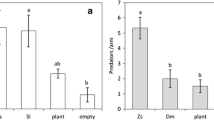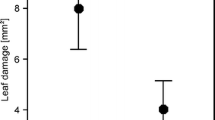Abstract
If predators lack information on the prey's position, prey have more chance to escape predation and will therefore reach higher population densities. One of the many possible cues that predators may use to find their prey are herbivore-induced plant volatiles. Although their effects on the behaviour of foraging predators have been well studied, little is known about how these prey-related odours affect predator–prey dynamics on a plant. We hypothesise that herbivore-induced plant volatiles provide the major cue eliciting predator arrestment on prey-infested leaves and that the response to these volatiles ultimately leads to lower prey densities. To test this hypothesis experimentally, we created two types of odour-saturated environments: one with herbivore-induced plant volatiles (treatment), and one with green-leaf volatiles (control). An odour-free environment could not be tested because herbivores require plants for population growth. We measured the rate at which predatory mites (Phytoseiulus persimilis) immigrate, emigrate and exploit a single leaf infested by two-spotted spider mites (Tetranychus urticae). The experiments did not show a significant difference between treatment and control. At best, there was a somewhat higher rate of predator (and possibly also prey) emigration in the treatment. The lack of a pronounced difference between treatment and control indicates that at the spatial scale of the experiments random searching for prey was as effective as directional searching. Alternatively, predators were arrested in the prey patch by responding not merely to herbivore-induced plant volatiles, but also to other prey-related cues, such as web and faeces. Based on our current experience we advocate to increase the spatial scale of the experiment (> 1 m2) and we provide other suggestions for improving the set-up.
Similar content being viewed by others
References
Dicke, M., Sabelis, M.W., Takabayashi, J., Bruin, J. and Posthumus, M.A. 1990. Plant strategies of manipulating predator-prey interactions through allelochemicals: prospects for application in pest control. J. Chem. Ecol. 16: 3091–3118.
Dicke, M., Van Baarlen, P., Wessels, R. and Dijkman, H. 1993. Herbivory induces systemic production of plant volatiles that attract predators of the herbivore-extraction of endogenous elicitor. J. Chem. Ecol. 19: 581–599.
Drukker, B., Jacobs, G., Bruin, J. and Sabelis, M.W. 2000. How predatory arthropods learn to cope with variability in volatile plant signals in the environment of their herbivorous prey. Exp. Appl. Acarol. (in press).
Margolies, D.C., Sabelis, M.W. and Boyer, J.E., Jr. 1997. Response of a phytoseiid predator to herbivore-induced plant volatiles: Selection on attraction and effect on prey exploitation. J. Ins. Behav. 10: 695–709.
Maeda, T., Takabayashi, J., Yano, S. and Takafuji, A. 1998. Factors affecting the resident time of the predatory mite Phytoseiulus persimilis (Acari: Phytoseiidae) in a prey patch. Appl. Entomol. Zool. 33: 573–576.
Mayland, H., Margolies, D.C. and Charlton, R.E. 2000. Multiple prey-related cues influence residence time of an acarine predator, Phytoseiulus persimilis. Entomol. Exp. Appl. 95: in press.
Pallini, A., Janssen, A. and Sabelis, M.W. 1997. Odour-mediated responses of phytophagous mites to conspecific and heterospecific competitors. Oecologia 110: 179–185.
Pels, B. and Sabelis, M.W. 1999. Local dynamics, overexploitation and predator dispersal in an acarine predator-prey system. Oikos 86: 573–583.
Sabelis,M.W. and Van de Baan, H.E. 1983. Location of distant spider mite colonies by phytoseiid predators: demonstration of specific kairomones emitted by Tetranychus urticae and Panonychus ulmi. Entomol. Exp. Appl. 33: 303–314.
Sabelis, M.W., Vermaat, J.E. and Groeneveld, A. 1984. Arrestment responses of the predatory mite, Phytoseiulus persimilis, to steep odour gradients of a kairomone. Physiol. Entomol. 9: 437–446.
Sabelis, M.W. and Van der Meer, J. 1986. Local dynamics of the interaction between predatory mites and two-spotted spider mites. In: The dynamics of physiologically structured populations, J.A.J. Metz, and O. Diekmann (eds), Lecture Notes in Biomathematics 68, pp. 322–344. Springer-Verlag, Berlin.
Sabelis, M.W. and Afman, B.P. 1994. Synomone-induced suppression of take-off in the phytoseiid mite Phytoseiulus persimilis Athias-Henriot. Exp. Appl. Acarol. 18: 711–721.
Sabelis, M.W., Van Baalen, M., Bakker, F.M., Bruin, J., Drukker, B., Egas, M., Janssen, A.R.M., Lesna, I.K., Pels, B., Van Rijn, P.C.J. and Scutareanu, P. 1999. The evolution of direct and indirect plant defence against herbivorous arthropods. In: Herbivores: Between Plants and Predators, H. Olff, V.K. Brown and R.H. Drent (eds), pp. 109–166. Blackwell Science, Oxford.
Schütte, C., Van Baarlen, P., Dijkman, H. and Dicke, M. 1998. Change in foraging behaviour of the predatory mite Pytoseiulus persimilis after exposure to dead conspecifics and their products. Entomol. Exp. Appl. 88: 295–300.
Van Baalen, M. and Sabelis, M.W. 1995. The milker-killer dilemma in spatially structured predator-prey interactions. Oikos 74: 391–413.
Author information
Authors and Affiliations
Rights and permissions
About this article
Cite this article
Pels, B., Sabelis, M.W. Do Herbivore-Induced Plant Volatiles Influence Predator Migration and Local Dynamics of Herbivorous and Predatory Mites?. Exp Appl Acarol 24, 427–440 (2000). https://doi.org/10.1023/A:1006436723266
Issue Date:
DOI: https://doi.org/10.1023/A:1006436723266




